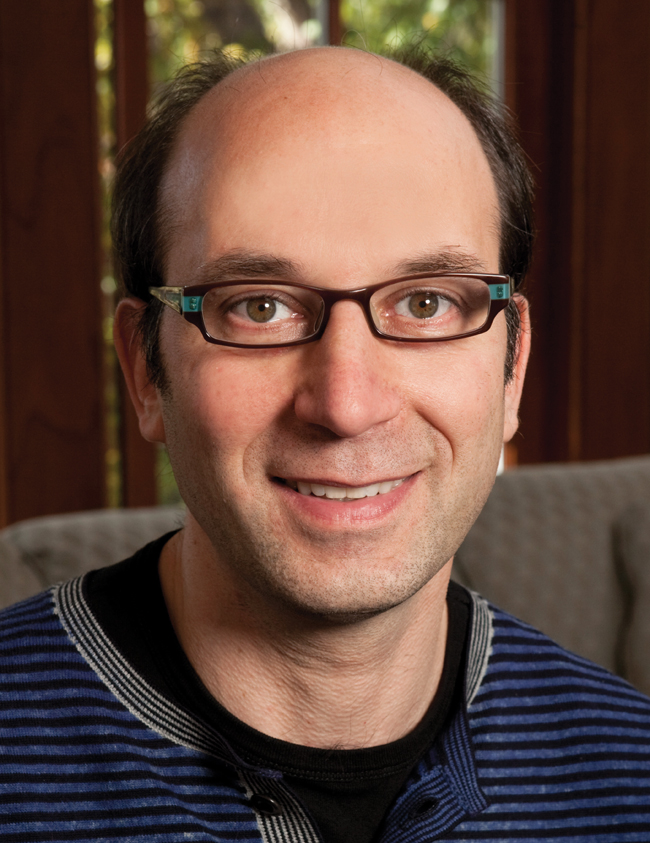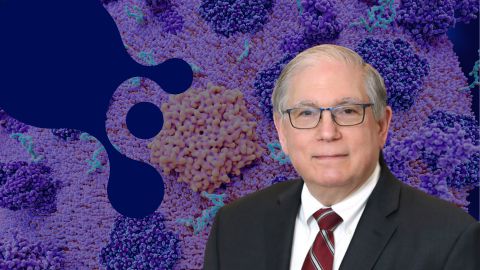Meet Jonathan Weissman
The plenary speaker for this year’s American Society for Biochemistry and Molecular Biology annual meeting is Jonathan Weissman of the University of California, San Francisco. An investigator with the Howard Hughes Medical Institute, Weissman is a protein biochemist whose laboratory focuses on protein folding, amyloid formation and next-generation genomic sequencing. ASBMB’s science writer, Rajendrani Mukhopadhyay, spoke with Weissman to learn more about his scientific interests and influences. The interview has been edited for length and clarity.
What does your research focus on?
We’re interested in how proteins fold in cells, especially how chaperones assist protein quality control and how a cell distinguishes between correct and incorrect proteins both in the cytosol and endoplasmic reticulum. We also have a broad interest in developing general approaches for querying biological systems, especially around next-generation sequencing. The most mature of those efforts is an approach we call ribosome profiling. It allows us to globally monitor translation in cells at single-nucleotide resolution.

This idea of using deep sequencing techniques to define the information encoded with these genomes and to watch it being expressed in space and time is really exciting. Ribosome profiling is one example of these techniques. We get to watch, with exquisite precision, the ribosome get in the act of converting an informational molecule, the RNA, into a functional molecule, the protein.
I’ll be talking about our ribosome-profiling work during my plenary lecture.
What was the genesis for ribosome profiling?
Our original interest was on the yeast prion phenomenon called [PSI+]. The phenotype of [PSI+] is that when the cell contains this prion, or self-propagating infectious protein, it increases the rate of translation read-through. We wanted to develop an assay that let us watch where ribosomes were reading through stop codons in vivo. But then, once we developed ribosome profiling, it was clear it was a much broader tool.
What are some of the technical challenges with ribosomal profiling?
The biggest challenge is interpretation and data analysis. We get huge amounts of data. It takes longer for us to analyze the data and ask the right questions than it does to actually collect the data. The other technical challenge is working with relatively small amounts of cells. We’d really like to optimize the amount of sample we use in our system.
How do you balance your scientific efforts between asking fundamental biological questions and developing techniques?
For my lab, it’s very important that the techniques we develop be driven by fundamental questions that we want to answer. My lab is very interested in seeing what happens to a protein as it’s synthesized and how it is recognized by the cell’s quality-control systems and doing this in an in vivo setting. Although the ribosome profiling is an -omics tool and it broadly looks at protein translation, I’m personally most excited about its value as a high-precision tool for looking at mechanisms of how proteins are synthesized and folded. I see the methods development as something that drives our ability to ask questions that we want to ask.
To put your work in a larger context, what do you think are some of the big-picture questions in biochemistry and molecular biology?
One of the things is: How do cells maintain integrity of their proteome and detect misfolded proteins? How do the different quality-control systems work together in a coherent way to allow cells to function, and when and why do they break down?
I think there’s another, broader question of how we define the function of a protein. What do we mean when we identify protein X to do job Y? A lot of this has been classically done, arguably, in an ad hoc way where you look for some activity in a cell and you try to find the proteins that are responsible for it. You do biochemical and genetic assays and say protein X is involved in DNA replication. Maybe you set up an in vitro system, solve the crystal structure (of protein X) and find out which side chains are catalyzing the addition of the next nucleotide.
This type of reductionist, top-down approach has been incredibly successful, but it has some inherent flaws and biases to it. We’re trying to develop more systematic and less ad hoc, more principled and faster approaches to finding gene function.
The other general area, which is related, is that we have built tools with which we can sequence any individual or organism’s genome rapidly and at low cost. There’s now a huge challenge to define the information encoded in genomes and how it’s expressed in time. Ribosomal profiling is a part of that effort. It lets you know what proteins are being encoded for in a cell in an objective way and see how much is made at a given time. If we really want to test our ideas and try to use this information to design new systems, we have to have much better ways of turning on and off genes and to engineer genomes. I’m very excited about approaches that we and others are working on using the CRISPR system.
Tell me more about the CRISPR system.
CRISPR is an adaptive-immunity system from bacteria that’s been known for some time. It’s turned out to be a very useful system for engineering genomes. The CRISPR system that has become particularly popular now is the CAS9-based system. In a nutshell, when a cell becomes infected with a phage, it grabs part of the phage’s DNA and inserts it into its own genome in these special cluster repeat regions. It then later transcribes that copy of the phage DNA as RNA and uses that RNA to guide an endonuclease (called) CAS9. Now, if the bacterium is ever infected with the same phage, the CAS9 plus this guide RNA will specifically cut up that phage DNA by hybridization.
What revolutionized things is that Emmanuelle Charpentier (at Molecular Infection Medicine Sweden) and Jennifer Doudna (at University of California, Berkeley) showed that a single protein, CAS9, and a single engineered guide RNA are sufficient to guide the CAS9 endonuclease to a given sequence. So if you give me a piece of DNA, I can design the complementary guide RNA. If you then express that guide RNA plus CAS9, the CAS9-guide-RNA complex will cleave that piece of DNA.
At UCSF, working with Stanley Qi and Wendell Lim, among others, we have made a catalytically dead version of CAS9, the so-called dCAS9. Now the guide RNA guides the dCAS9 to a specific place on the DNA, but instead of cutting it, it just sits there. You can then use this (dCAS9) to fuse gene-activator domains to turn on genes; if you fuse repressors, it will turn off genes. If you fuse GFP, it will mark that part of the chromosome. It lets us turn on and off genes and mark chromosomes without actually causing any changes in the DNA blueprint itself. I think it may even be a competitor to RNAi approaches.
I will also mention the CRISPR work during my talk.
Your undergraduate degree and Ph.D. were both in physics from the Massachusetts Institute of Technology. How did you make the switch from physics to biology?
To be honest, I did get my Ph.D. in physics, but what really happened is that, after a year of doing hardcore physics in phase transitions and all that, I decided I was much more interested in biological questions. I found Peter Kim, who was then a professor at MIT in the Whitehead Institute of Biomedical Research. I rotated and then joined his lab. I did all my qualifying exams in physics, but I did my research in a mainstream biological laboratory. That meant I had to take a lot of courses and spend a lot of time catching up, because I had very little biology (training). But, by the time I had graduated (with my Ph.D.), I was pretty well immersed in modern molecular biology. But fast-forward 15 years later, all the quantitative tools, like deep sequencing, are incredibly valuable. There has been this convergence where biology has become an information-rich science. All that training I had in physics and math actually ended up being extremely useful.
You did your postdoctoral fellowship with Arthur Horwich at Yale University. How did that experience influence you?
Enormously. We did great work on the biochemistry of GroEL and really got into the structure-function aspect. It was a terrific time. I wasn’t there all that much time, about 2 ½ years, but I published four papers from that time that, in many ways, cemented the standard model for GroEL and how proteins fold inside the central cavity of GroEL. It was a wonderful time because the structures were coming out from Art’s lab so we were able to exploit the structural information.
I read in Horwich’s “Reflections” in the Journal of Biological Chemistry that you kept chameleons in the lab. He described them as even more finicky eaters than children.
I did indeed have a Jackson’s chameleon, Lance. It required taking crickets and coating them with vitamin D and calcium and holding them in front of it every day. (Chameleons) apparently don’t get much vitamin D and calcium when they are in captivity, so you have to give them vitamin D and calcium.
Who are your scientific influences?
Obviously, my Ph.D. adviser, Peter Kim, and my postdoctoral adviser, Art Horwich. Also, I used to go to group meetings of Ari Helenius’ laboratory (at Yale University). I really learned a lot about how cell biologists think. My father, who is a molecular biologist, is a huge influence. He’s Sherman Weissman, and he’s at Yale. We talked a lot about science when I was growing up. We still do. Here (at UCSF), I’ve had many mentors and collaborators. Marshall Nirenberg (who worked at the National Institutes of Health) was certainly a big influence as well. We talked a lot about translation. I came into translation independently and then had the good fortune of being able to talk with Marshall about it. I learned that many of the ribosome experiments we were doing were done back in the 1960s. They had fewer good tools, but they understood the concepts. (Editor’s note: Nirenberg had married Weissman’s mother, who was divorced from Sherman Weissman.)
What is your guiding principle in science?
Try to find new questions that are fundamental and important, but they should be ones we can answer in a clean and crisp way. I really like problems that lend themselves to very clear, definitive answers rather than problems where one ends up going back and forth with arguments because it’s hard to resolve anything. The GroEL work illustrated that nicely: When I was a postdoc in Art’s lab, a big question, and it was quite controversial at that time, was if proteins fold inside the GroEL/GroES cavity or on the outside. It was an incredible idea that a protein could get encapsulated in another protein and fold in this protected environment. But I liked the problem, because it was easy to explain to anyone and it was going to be one way or the other. I was quite confident that we, or other people, would be clever enough to figure it out. I also like developing approaches, especially when they let you ask questions in a deeper and more defined way and much more rapidly. I always worry about spending our time doing hard work on something when, if we had a new approach, it would make what we do obsolete.
What are your hobbies?
Since I spend pretty much no time now doing experiments, I really love to cook, especially things that are based around techniques. I’ve been perfecting using my grill as a pizza oven, getting the temperature up to about 700 degrees and making the perfect dough. My lab just gave me a 40-pound slab of steel for my pizza stone because it conducts heat much better. But it’s also great at inducing back pain.
Enjoy reading ASBMB Today?
Become a member to receive the print edition four times a year and the digital edition monthly.
Learn moreGet the latest from ASBMB Today
Enter your email address, and we’ll send you a weekly email with recent articles, interviews and more.
Latest in People
People highlights or most popular articles

Quieting the static: Building inclusive STEM classrooms
Christin Monroe, an assistant professor of chemistry at Landmark College, offers practical tips to help educators make their classrooms more accessible to neurodivergent scientists.

Hidden strengths of an autistic scientist
Navigating the world of scientific research as an autistic scientist comes with unique challenges —microaggressions, communication hurdles and the constant pressure to conform to social norms, postbaccalaureate student Taylor Stolberg writes.

Richard Silverman to speak at ASBMB 2025
Richard Silverman and Melissa Moore are the featured speakers at the ASBMB annual meeting to be held April 12-15 in Chicago.

Women’s History Month: Educating and inspiring generations
Through early classroom experiences, undergraduate education and advanced research training, women leaders are shaping a more inclusive and supportive scientific community.

ASBMB honors Lawrence Tabak with public service award
He will deliver prerecorded remarks at the 2025 ASBMB Annual Meeting in Chicago.

ASBMB names 2025 JBC/Tabor Award winners
The six awardees are first authors of outstanding papers published in 2024 in the Journal of Biological Chemistry.

